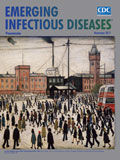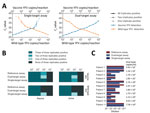
Volume 23, Number 11—November 2017
Dispatch
Lineage-Specific Real-Time RT-PCR for Yellow Fever Virus Outbreak Surveillance, Brazil
On This Page
Carlo Fischer1, Maria C. Torres1, Pranav Patel, Andres Moreira-Soto, Ernest A. Gould, Rémi N. Charrel, Xavier de Lamballerie, Rita Maria Ribeiro Nogueira, Patricia C. Sequeira, Cintia D.S. Rodrigues, Beate M. Kümmerer, Christian Drosten, Olfert Landt, Ana Maria Bispo de Filippis , and Jan Felix Drexler
, and Jan Felix Drexler
Abstract
The current yellow fever outbreak in Brazil prompted widespread yellow fever virus (YFV) vaccination campaigns, imposing a responsibility to distinguish between vaccine- and wild-type YFV-associated disease. We developed novel multiplex real-time reverse transcription PCRs that differentiate between vaccine and American wild-type YFV. We validated these highly specific and sensitive assays in an outbreak setting.
Yellow fever virus (YFV) is a mosquitoborne member of the genus Flavivirus within the family Flaviviridae(Technical Appendix[PDF - 746 KB - 3 pages] Figure 1, panel A) that is endemic to Africa and South America (1). Within YFV, 2 American and at least 3 African genotypes can be differentiated (2). The American YFV genotypes evolved from ancestral African viruses several hundred years ago and now are found only in South America (3).
In December 2016, Brazil reported the country’s largest yellow fever (YF) outbreak in decades. Through May 31, 2017, a total of 3,240 suspected cases were reported, including 435 deaths (4). The geographically widespread outbreak was caused by the American genotype 1 (Technical Appendix[PDF - 746 KB - 3 pages] Figure 1, panel B) (5). In response to the outbreak, authorities launched large-scale vaccination campaigns aimed at distributing >20 million doses of YFV vaccine (6). Two different live-attenuated vaccines are being deployed. Most contain the vaccine strain 17DD, produced in Brazil (7). International authorities are deploying another 3.5 million doses of the standard vaccine strain, 17D (6). Both vaccine strains originate from the same parental strain, Asibi, and represent the West African genotype 2 (Technical Appendix[PDF - 746 KB - 3 pages] Figure 1, panel B).
While YFV vaccines are considered safe, rare vaccine-associated adverse events (YF-VAAE) can occur (8). Viscerotropic YF-VAAE symptoms can overlap those of YF disease (9). In YFV-endemic regions, it is essential to distinguish between YF-VAAE and wild-type YFV infection (10). Routine diagnostic procedures can take several days, usually requiring 2 separate steps, detection and strain characterization by nucleotide sequencing. Here, we present 2 highly sensitive real-time reverse transcription PCRs (RT-PCRs) designed to detect and discriminate between YFV vaccine and American wild-type (hereafter referred to as wild-type) strains within 1 hour.

Figure 1. Design of new real-time RT-PCRs for differentiation between vaccine and wild-type YFV. A) YFV genomic representation (GenBank accession no. DQ100292) with real-time RT-PCR target sites, indicated by arrowheads, and identity plot...
We followed 2 rationales for real-time RT-PCR design. First, a small number of oligonucleotides per assay can be beneficial in resource-limited settings. Therefore, we designed 5 different single-target assays using primers capable of simultaneously amplifying vaccine and wild-type YFV strains. However, these criteria restricted the ability to design optimal oligonucleotides. Therefore, we designed 2 additional dual-target assays that target 2 separate genomic regions in which vaccine and wild-type strains differ sufficiently from one another (Figure 1, panel A). Vaccine and wild-type strains were generally discriminated by lineage-specific hydrolysis probes within a single tube reaction, incapable of detecting the heterologous lineage due to high numbers of nucleotide mismatches under oligonucleotide binding sites (Figure 1, panel B) (12).
We selected the 2 most sensitive single- and dual-target assays on the basis of preliminary experiments using full viral RNA of wild-type and vaccine strains (Table; Technical Appendix[PDF - 746 KB - 3 pages] Figure 2). For assay validation and quantification, we designed 2 in vitro transcripts (IVTs) based on the vaccine strain 17DD and an outbreak strain from Brazil (5), as described previously (12).
The 95% lower limit of detection of the single- and dual-target assays ranged from 4.0 to 8.8 RNA copies/reaction for vaccine and wild-type YFV strains (Technical Appendix[PDF - 746 KB - 3 pages] Figure 3). Discrimination between vaccine and wild-type strains was reliable even at high concentrations of IVTs and full viral RNA in the range of 106 copies/reaction. Assay specificity was assessed using a set of 39 high-titer flavivirus cell culture isolates (Technical Appendix[PDF - 746 KB - 3 pages] Figure 1, panel A), all of which tested negative in the novel assays.

Figure 2. Validation of new real-time RT-PCRs for differentiation between vaccine and wild-type YFV. A) Effects of target competition on YFV real-time RT-PCRs. Mean cycle threshold (Ct) values are plotted against IVT concentrations....
Hypothetically, near-simultaneous infection with wild-type YFV and vaccination may occur in the outbreak setting in Brazil. In the case of co-occurrence of vaccine and wild-type YFV within a single sample, 1 target may occur in relatively higher concentrations than, and thus outcompete amplification of, the other target, resulting in an incomplete test result. We observed no target competition with the dual-target assay even in the presence of high concentrations of the heterologous RNA (Figure 2, panel A). In contrast, the single-target assay showed decreased sensitivity at <1,000 copies/reaction upon the presence of 100–500-fold higher concentrations of the heterologous target.
Commonly used clinical specimens for YFV diagnostics may contain substances that can interfere with PCR (13). To assess our assays’ performance in different clinical matrices, we used human plasma and urine previously tested negative for YFV and spiked them with 101–106 copies/mL of either vaccine or wild-type YFV. Three replicates of each spiked specimen were purified individually and tested by using our PCRs and a YFV reference assay (13). We detected samples containing >1,000 copies/mL in all replicates irrespective of the clinical matrix (Figure 2, panel B). Detection of samples containing <100 copies/mL was unreliable in all 3 assays. As exemplified before for Zika virus, final RNA copy numbers in eluates used for RT-PCR will depend on the RNA extraction protocol, illustrating that even assays with analytical sensitivity in the single-copy range may not correctly detect weakly positive clinical specimens (12).
Clinical specimens may differ from spiked materials, and assay performance needs to be assessed in an outbreak context. Therefore, we compared the new assays to the reference assay (13) in a Brazilian flavivirus reference laboratory, using different clinical specimens obtained from 11 YF cases previously confirmed by nucleotide sequencing as wild-type YFV infections. The sensitivity of the dual-target assay was identical to that of the reference assay, whereas the single-target assay was slightly less sensitive (Figure 2, panel C). Identification of wild-type YFV was reliable in all cases, consistent with specific detection of lineages even in highly positive clinical specimens.
The new PCRs we describe enable YFV detection with diagnostic sensitivity. The dual-target assay was superior to the single-target assay in sensitivity and robustness to target competition. However, the single-target assay may be advantageous in resource-limited settings and may be more convenient for multiplex usage in combination with assays targeting co-circulating arboviruses, such as chikungunya, Zika, and dengue viruses. Beyond rapid test results, the real-time RT-PCR–based protocols provide considerably higher sensitivity than protocols aiming at generating longer PCR amplicons necessary for strain discrimination by nucleotide sequencing, enabling conclusive results even when virus concentrations in specimens are low or when these materials are available only in limited quantity. Of note, PCR-based YFV detection is most reliable 5–7 days after symptom onset, during the viremic phase. Reliable YFV surveillance should thus include serologic methods. However, serologic tests used for virologic diagnostics cannot discriminate between vaccination and wild-type YFV infection.
Of note, our novel assays are limited to vaccine and American YFV wild-type strains. West African wild-type stains would be detected by our YFV vaccine assays due to the close genetic relatedness between these strains, but our assays are not suitable to detect the genetically diverse Eastern and Central African wild-type strains. If needed, one could extend our assays by an additional primer/probe combination targeting the Eastern and Central African genotypes.
Recently, the first attenuated live dengue virus vaccine was approved in several countries, including Brazil (14). Inactivated Japanese encephalitis virus vaccines are currently replaced by attenuated live vaccines in Asia (15), and an attenuated live West Nile virus vaccine has completed a phase II clinical trial (16). Large-scale deployment of these vaccines will raise the need to discriminate between potential vaccination-associated events and wild-type virus infection in symptomatic patients. Our work with YFV may provide a diagnostic blueprint for establishing and validating suitable methods for differentiating between vaccine and wild-type viruses for these other viruses as well.
Mr. Fischer is a PhD student at the Institute of Virology of the University of Bonn Medical Centre and the German Centre for Infection Research. His main research interests are diagnostics of emerging arboviruses.
Acknowledgments
We thank Monika Eschbach-Bludau, Janett Wieseler, and Tobias Bleicker. Positive controls for reaction control and quantification are available at the EVAg portal (https://www.european-virus-archive.com).
This work was partially supported by the European Union’s Horizon 2020 research and innovation program (ZIKAlliance, grant agreement no. 734548; EVAg, grant agreement no. 653316; Zikaplan, grant agreement no. 734584); the German Centre for Infection Research through the ZIKApath project; the Faperj (Fundação de Amparo à Pesquisa do estado do Rio de Janeiro, grant no. E-18/2015TXB); and the Secretaria de Vigilância em Saúde/Coordenação Geral de Laboratórios de Saúde Pública/Ministério da Saúde do Brasil.
References
- Gardner CL, Ryman KD. Yellow fever: a reemerging threat. Clin Lab Med. 2010;30:237–60. DOIPubMed
- Beasley DW, McAuley AJ, Bente DA. Yellow fever virus: genetic and phenotypic diversity and implications for detection, prevention and therapy.Antiviral Res. 2015;115:48–70. DOIPubMed
- Bryant JE, Holmes EC, Barrett AD. Out of Africa: a molecular perspective on the introduction of yellow fever virus into the Americas. [<jrn>]. PLoS Pathog. 2007;3:e75. DOIPubMed
- Ministério da Saúde Brazil. Informe especial febre amarela no Brasil Nº 01/2017: Ministério da Saúde 2017 [cited 2017 Sep 1]. http://portalarquivos.saude.gov.br/images/pdf/2017/marco/18/Informe-especial-COES-FA.pdf
- Bonaldo MC, Gómez MM, Dos Santos AA, Abreu FVS, Ferreira-de-Brito A, Miranda RM, et al. Genome analysis of yellow fever virus of the ongoing outbreak in Brazil reveals polymorphisms. Mem Inst Oswaldo Cruz. 2017;112:447–51. DOIPubMed
- World Health Organization. WHO dispatched 3.5 million doses of yellow fever vaccine for outbreak response in Brazil. 2017 30 March 2017 [cited 2017 Aug 30]. http://www.who.int/csr/disease/yellowfev/vaccination-in-Brazil/en/
- de Melo AB, da Silva MP, Magalhães MC, Gonzales Gil LH, Freese de Carvalho EM, Braga-Neto UM, et al. Description of a prospective 17DD yellow fever vaccine cohort in Recife, Brazil. Am J Trop Med Hyg. 2011;85:739–47. DOIPubMed
- Thomas RE. Yellow fever vaccine-associated viscerotropic disease: current perspectives. Drug Des Devel Ther. 2016;10:3345–53. DOIPubMed
- Monath TP, Vasconcelos PF. Yellow fever. J Clin Virol. 2015;64:160–73. DOIPubMed
- Boyd AT, Dombaxe D, Moreira R, Oliveira MS, Manuel E, Colorado CN, et al. Notes from the field: investigation of patients testing positive for yellow fever viral RNA after vaccination during a mass yellow fever vaccination campaign—Angola, 2016. MMWR Morb Mortal Wkly Rep. 2017;66:282–3. DOIPubMed
- Simmonds P. SSE: a nucleotide and amino acid sequence analysis platform. BMC Res Notes. 2012;5:50–9. DOIPubMed
- Corman VM, Rasche A, Baronti C, Aldabbagh S, Cadar D, Reusken CB, et al. Assay optimization for molecular detection of Zika virus. Bull World Health Organ. 2016;94:880–92. DOIPubMed
- Domingo C, Patel P, Yillah J, Weidmann M, Méndez JA, Nakouné ER, et al. Advanced yellow fever virus genome detection in point-of-care facilities and reference laboratories. J Clin Microbiol. 2012;50:4054–60. DOIPubMed
- World Health Organization. Dengue vaccine: WHO position paper – July 2016. Wkly Epidemiol Rec. 2016;91:349–64.PubMed
- Hegde NR, Gore MM. Japanese encephalitis vaccines: Immunogenicity, protective efficacy, effectiveness, and impact on the burden of disease. Hum Vaccin Immunother. 2017;13:1–18. DOIPubMed
- Dayan GH, Bevilacqua J, Coleman D, Buldo A, Risi G. Phase II, dose ranging study of the safety and immunogenicity of single dose West Nile vaccine in healthy adults ≥ 50 years of age. Vaccine. 2012;30:6656–64. DOIPubMed
Figures
Table
Technical Appendix
Cite This Article1These authors contributed equally to this article.






















.png)











No hay comentarios:
Publicar un comentario